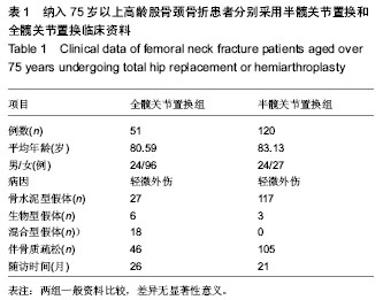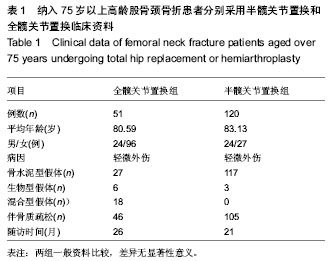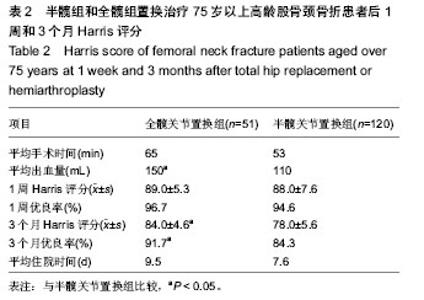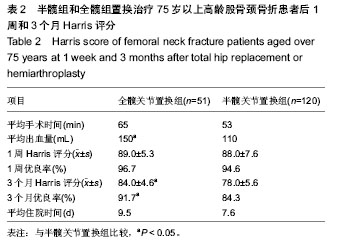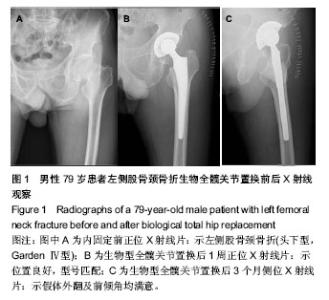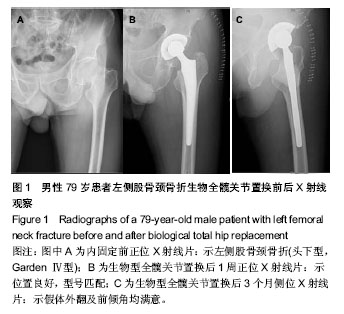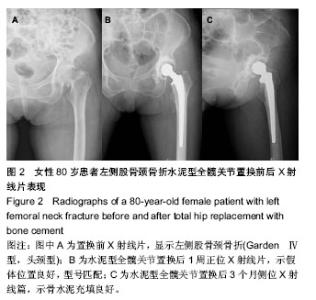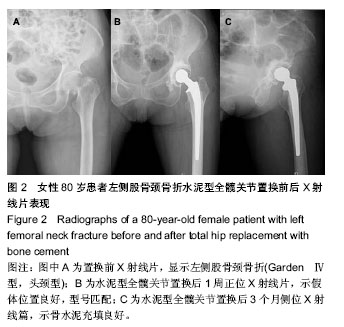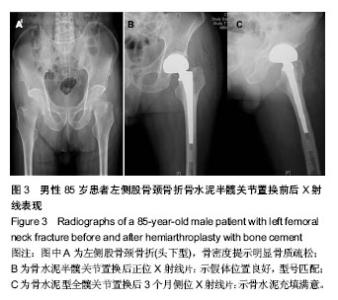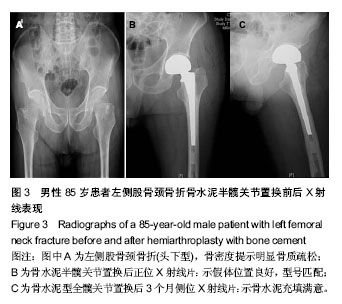| [1] SooHoo NF, Farng E, Chambers L, et al. Comparison of complication rates between hemiarthroplasty and total hip arthroplasty for intracapsular hip fractures. Orthopedics. 2013;36(4):e384-389.
[2] 马俊,宁显明,邵大洪.全髋关节和人工股骨头置换术治疗高龄患者股骨颈骨折的临床效果比较[J].山东医药,2010,50(3):66-67.
[3] Gjertsen JE, Vinje T, Engesaeter LB, et al. Internal screw fixation compared with bipolar hemiarthroplasty for treatment of displaced femoral neck fractures in elderly patients. J Bone Joint Surg Am. 2010;92(3):619-628.
[4] Dai Z, Li Y, Jiang D. Meta-analysis comparing arthroplasty with internal fixation for displaced femoral neck fracture in the elderly. J Surg Res. 2011;165(1):68-74.
[5] 李忠泽,杨惠光,张云庆,等. 75岁以上老年人股骨颈骨折初次全髋关节置换术[J].中国骨与关节损伤杂志,2009,24(2):140-141.
[6] 廖兴华,冯梅,曹智全,等.高龄股骨颈骨折二种髋关节置换术式比较[J].浙江临床医学,2012,14(12):1482-1484.
[7] Baker RP, Squires B, Gargan MF, et al. Total hip arthroplasty and hemiarthroplasty in mobile, independent patients with a displaced intracapsular fracture of the femoral neck. A randomized, controlled trial. J Bone Joint Surg Am. 2006;88(12):2583-2589.
[8] Blomfeldt R, Törnkvist H, Eriksson K, et al. A randomised controlled trial comparing bipolar hemiarthroplasty with total hip replacement for displaced intracapsular fractures of the femoral neck in elderly patients. J Bone Joint Surg Br. 2007;89(2):160-165.
[9] 顾建明,杜辉,邵宏翊,等.股骨转子下截骨的全髋关节置换治疗高脱位髋臼发育不良[J].中国组织工程研究,2013,17(48): 8331-8336.
[10] 廖亮,赵劲民,苏伟,等.全髋与半髋关节置换治疗老年股骨颈骨折的Meta分析[J].中国组织工程研究与临床康复,2010,14(22): 3991-3995.
[11] Healy WL, Iorio R. Total hip arthroplasty: optimal treatment for displaced femoral neck fractures in elderly patients. Clin Orthop Relat Res. 2004;(429):43-48.
[12] Harris WH.Traumatic arthritis of the hip after dislocation and acetabular fractures: treatment by mold arthroplasty. An end-result study using a new method of result evaluation.J Bone Joint Surg. 1969;51A:737-755.
[13] 严胜军,卢水生,黄夏雨,等.全髋关节与双极人工股骨头置换手术治疗老年股骨颈骨折的疗效[J].中国老年学杂志,2012, 32(2):277-278.
[14] Gao H, Liu Z, Xing D, et al. Which is the best alternative for displaced femoral neck fractures in the elderly?: A meta-analysis. Clin Orthop Relat Res. 2012;470(6): 1782-1791.
[15] 宋海明,杜宁. 老年髋关节置换与腰麻复合腰丛阻滞麻醉[J]. 中国组织工程研究与临床康复,2010,14(26):4858-4861.
[16] 席学义.全髋关节置换术与人工股骨头置换术治疗高龄股骨颈骨折的疗效比较[J].河南外科学杂志,2013,20(07):4-6.
[17] 高玉镭,王东辰,李佩佳,等.人工全髋关节置换术隐性失血量的估算及原因分析[J].实用医药杂志,2012,29(6):490-492.
[18] 陈科,吕小华,曾荣,等.初次髋关节置换后不放置引流管的安全性[J].中国组织工程研究,2012,26(8):6494-6497.
[19] Keating JF, Grant A, Masson M, et al. Displaced intracapsular hip fractures in fit, older people: a randomised comparison of reduction and fixation, bipolar hemiarthroplasty and total hip arthroplasty. Health Technol Assess. 2005;9(41):iii-iv, ix-x, 1-65.
[20] 周传友,尚希福. 全髋关节置换术后脱位原因研究进展[J]. 国际骨科学杂志,2010,31(3): 169-170.
[21] Masonis JL, Bourne RB. Surgical approach, abductor function, and total hip arthroplasty dislocation. Clin Orthop Relat Res. 2002;(405):46-53.
[22] Girard J, Lavigne M, Vendittoli PA, et al.Biomechanical reconstruction of the hip: a randomised study comparing total hip resurfacing and total hip arthroplasty.J BoneJoint Surg Br. 2006;88(7):721-726.
[23] Kwok,DC.and RL,Cruess.A retrospective study of Moore and Thompson hemiarthroplasty.A review of 599 surgical cases and an analysis of the technical complications.Clin Orthop Relat Res.1982(169):179-185.
[24] 刘威.人工髋关节置换术的并发症及应对措施[J].中国药物警戒,2012,9(4):215-217.
[25] Khan RJ, MacDowell A, Crossman P, et al. Cemented or uncemented hemiarthroplasty for displaced intracapsular fractures of the hip--a systematic review. Injury. 2002;33(1):13-17.
[26] 赵耀,汤健,李全利.老年骨质疏松性股骨颈骨折关节置换的选择:是人工股骨头还是全髋关节?[J]. 中国组织工程研究,2012, 16(9):1692-1694. |
